Artificial Intelligence in the Urban Environment: Smart Cities as Models for Developing Innovation and Sustainability
Abstract
1. Introduction
2. Theoretical Background
2.1. Theoretical Focus
2.1.1. Relationship between Innovation and AI: Dynamic Capabilities Theory
2.1.2. Relationship between Connectivity and AI: Complexity Theory
- Facebook recently disclosed plans to invest in AI at the annual F8 conference.
- Baidu is investing heavily in artificial intelligence: “The era of mobile Internet is over.” In fact, 5G, which focuses on AI, is becoming a disruptive innovation of the Internet.
- JPMorgan is using AI to achieve high financial automation and increase employee productivity.
- Deloitte’s 2020 CEO Shelby Austin confirmed that the organization was thrilled to collaborate with the World Economic Forum and the government of the UK in the development of procurement guidelines that help the public sector put AI at the service of its constituents in a manner that is both efficient and ethical.
2.1.3. The Importance of Sustainability as a Resulting Performance
2.2. Current Problems: Overpopulation, Pollution, New Illnesses, and the Squandering of Resources
2.2.1. Overpopulation: Pressure Generated by Migration from Rural Areas to Urban Centers
2.2.2. Pollution: the Widespread Growth of Metropolises, which Generate Over 80% of Global Pollution
2.2.3. The Emergence of New Illnesses
2.2.4. Squandering of Resources: Greater Expenditure on Energy Consumption (Almost 80% of World Consumption)
2.3. Proposed Solution
- -
- Economic competitiveness: attracting and achieving financing for new firms, conserving existing ones, and achieving improvement in economic development [48];
- -
- Quality of life: improving health and security, new implications for healthcare, and changes in the way information is processed [44];
- -
- Sustainability: energy efficiency, social change, greater economic prospects, and changes in resource and risk management [49];
- -
- Mobility: efficiency in the means of transportation, traffic, and pollution, etc. [50].
3. Methodology and Methods
3.1. Sample
3.2. Measures
4. Results and Discussion
4.1. Data Analysis
- Malaga stands out for its energy efficiency and pollution reduction project, which reduced CO2 emissions by 20% and earned the city the classification of Good (scores of 3 and 4).
- Santander was one of the pioneers in developing a real-time traffic monitoring plan, with over 20,000 sensors distributed throughout the city.
- Valencia was one of the first cities to develop a citizen services management platform with the project fiware VLCi. Valencia is improving its position in the ranking of Smart Cities. This platform integrates key citizen services that span five areas of the city: governance, mobility, environmental management, wellbeing, and tourism.
- Barcelona uses a transportation network for a public bicycle service, intelligent devices in the home, and a real-time stock management system for available healthcare material, obtaining a score of Excellent. The city should, however, improve in some aspects which are classified as insufficient (e.g., little use of renewable energy in public transport, inefficient mobility (measured by traffic accidents per 1000 inhabitants), emergency citizen services, CO2 emissions per capita, number of homeless people, and average emergency response time).
- Most of Madrid’s indicators are classified as Excellent, with a score of 6. Madrid should, however, improve in some issues that continue to be classified as insufficient (e.g., the approximate percentage of electric energy consumption (kwh), number of accidents per 1000 inhabitants, average daily concentration of NO2, security in the use of mobile devices, and average emergency response time).
4.2. Measures Proposed to Overcome the Deficiencies Detected in the City of Granada
- As to governance measures, the number of ambulances per 100,000 inhabitants is 1.64 [67], one of the worst figures for the region. We propose a personalized service for each patient, with full transparency of information and an app for the real-time management of the waiting time for each patient [67].
- To foster government–citizen channels, Granada should work to create an e-government with participatory processes for citizens, elections accessible to its population, and e-administration to improve the quality of services. These proposals revolve around apps to enable citizens to participate in activities organized in the city, and information given in real time about municipal publications to exploit and optimize different areas of the city.
- The city lacks a great deal of knowledge on almost any online procedure. Procedures are performed in person, which makes digital integration difficult for citizens. Granada must create an open data network to make data accessible to all of its citizens. Such a network would enable transparency in local government action.
- As for mobility, Granada has about 30 km of bicycle paths [73]. The city’s orography makes it difficult to implement a network that reaches the Albaycin and Sacromonte neighborhoods. Further, most bike lanes are on the periphery, which makes them hard to use. We thus propose the focusing of the network on leisure and not functional mobility as a means of transportation. We propose the restructuring of the areas of the city center to reduce traffic congestion and increase the network to just 54% of the city’s metropolitan network.
- Establishing public charging stations for electric vehicles. Most are currently private. The power level required for the network should be 2.3–350 kw. Most of the charging stations in the city have a low power levels. If we compare Granada to Barcelona (the city with the highest number of charging stations (570 stations and 14 km2 per charging station)), Granada (with 35 stations and 361 km2 for each station) is deficient by a large margin in this measure [67,72].
- A total of 15% of the population uses public bus transportation in Granada, whereas 32% use cars [75]. The bus system’s 29 lines provide a complete but inefficient transportation network. Travelers are lost due to the saturation of users, especially with the large university population. We propose the development of online applications to manage urban traffic for visitors, and apps that register the type of visitor in order to adapt the city’s services to visitors’ habits and customs.
- As for the environment, around 30% of Granada’s waste is not treated as recyclable material [76]. We propose to raise urban awareness with brochures and information to improve these figures, and R&D projects to create smart networks that manage supply.
- The quantity of green space shows that Granada has a total of one tree per five inhabitants, or a shortfall of nearly 30,000 trees [74] to achieve the approximately 15 m2 that the WHO guidelines establish for green areas per inhabitant.
- Granada has approximately three fire fighters per 10,000 inhabitants, well below the European recommendations of 10 per 10,000 [68].
- As for economic measures, increasing the foreign resident population in the city is another key factor that Granada should foster from the perspective of multiculturalism. We propose the improvement of online reservations services, information at tourist access points, free WiFi, and secure data networks, etc.
- As for quality of life through universal accessibility, we propose the hiring of more disabled personnel in order to achieve greater social integration. Teleassistance for the elderly and/or disabled improves hospital security for these patients. Sensors enable the monitoring of subjects’ healthcare activity, providing information on their state of health in real time [77]. Another measure that we propose is the installation of more traffic lights with acoustical signals for the blind.
- Decreasing the percentage of the population living in poverty: one third of Granada’s population lives in poverty [78]. The city should bid to help entrepreneurs and firms access a commercial network that is more favorable to e-commerce and social networks. The city must also work to improve education, for example, by gradually changing the city’s tough education system to adopt new teaching styles that involve students in critical thinking, creativity, and innovation. It would also be beneficial to update education for 21st-century students, and provide an education system with digital tools that form part of the change in technological trends, digital blackboards, and tablets, etc., by making students aware of how to use them well.
- In the area of health, Granada must foster an increased birth rate in the population. The city’s population pyramid is inverted, with around 22% of the population being over 65 years old [79]. Other health-related areas in need of improvement are hospitals and the quality of healthcare [80]. We propose virtual reality projects in order to control stress and psychological processes. The system can use the waiting time for a virtual self-check to determine the patient’s state prior to an appointment with a specialist. A real-time stock management system for healthcare material could also be implemented, like that in Barcelona.
4.3. Discussion
5. Conclusions, Implications, Limitations and Future Research Lines
5.1. Theoretical Implications
5.2. Practical Implications
5.3. Limitations and Future Research Lines
5.4. Conclusions
Author Contributions
Funding
Conflicts of Interest
References
- United Nations. Cities Will Continue to Grow Especially in Developing Countries. Available online: https://bit.ly/2L8Abdc (accessed on 10 January 2020).
- Dameri, R.P. Smart City Implementation. In Creating Economic and Public Value in Innovative Urban Systems; Springer International Publishing: Cham, Switzerland, 2017; pp. 1–108. [Google Scholar]
- Huang, S.L.; Chen, C.W. Theory of Urban Energetics and mechanisms of urban development. Ecol. Model. 2005, 189, 49–71. [Google Scholar] [CrossRef]
- Caragliu, A.; Del Bo, C.; Nijkamp, P. Smart Cities in Europe. J. Urban Technol. 2011, 18, 65–82. [Google Scholar]
- Silvestre, B.S.; Tirca, D.M. Innovations for sustainable development: Moving toward a sustainable future. J. Clean. Prod. 2019, 208, 325–332. [Google Scholar]
- D’Adamo, I.; Falcone, P.M.; Martin, M.; Rosa, P. A sustainable revolution: Let’s go sustainable to get our globe cleaner. Sustainability 2020, 12, 4387. [Google Scholar] [CrossRef]
- Zaheer, A. On big data, artificial intelligence and smart cities. Cities 2019, 89, 80–91. [Google Scholar]
- Banco de España. Escenarios macroeconómicos de referencia para la economía española tras el Covid-19. Bol. Econ. Banco Espan. 2020, 2, 1–35. [Google Scholar]
- Bullough, A.; Renko, M. Entrepreneurial resilience during challenging times. Bus. Horiz. 2013, 56, 343–350. [Google Scholar]
- Elmqvist, T.; Andersson, E.; Frantzeskaki, N.; McPhearson, T.; Olsson, P.; Gaffney, O.; Takeuchi, K.; Folke, C. Sustainability and resilience for transformation in the urban century. Nat. Sustain. 2019, 2, 267–273. [Google Scholar]
- Roundy, P.T.; Brockman, B.K.; Bradshaw, M. The resilience of entrepreneurial ecosystems. J. Bus. Ventur. Ins. 2017, 8, 99–104. [Google Scholar]
- D’Adamo, I.; Rosa, P. How Do You See Infrastructure? Green Energy to Provide Economic Growth after COVID-19. Sustainability 2020, 12, 4738. [Google Scholar]
- Cocchia, A. Smart and Digital City: A Systematic Literature Review. In Smart City. Progress in IS; Dameri, R., Rosenthal-Sabroux, C., Eds.; Springer: Cham, Switzerland, 2014; pp. 13–43. [Google Scholar]
- Osiyevskyy, O.; Shirokova, G.; Ritala, P. Exploration and exploitation in crisis environment: Implications for level and variability of firm performance. J. Bus. Res. 2020, 114, 227–239. [Google Scholar] [CrossRef] [PubMed]
- Teece, D.; Pisano, G.; Shuen, A. Dynamic capabilities and strategic management. Strateg. Manag. J. 1997, 18, 509–533. [Google Scholar] [CrossRef]
- Cruz, J.; López, P.; Martín de Castro, G. La influencia de las capacidades dinámicas sobre los resultados financieros de la empresa. Cuad. Estud. Empres. 2009, 19, 105–128. [Google Scholar]
- McElroy, M.W. Integrating complexity theory, knowledge management and organizational learning. J. Knowl. Manag. 2000, 4, 195–203. [Google Scholar] [CrossRef]
- Corral de Zubielqui, G.; Jones, J.; Statsenko, L. Managing innovation networks for knowledge mobility and appropriability: A complexity perspective. Entrep. Res. J. 2016, 6, 75–109. [Google Scholar] [CrossRef]
- Martín-Rojas, R.; García-Morales, V.J.; Garrido-Moreno, A.; Salmador-Sanchez, M.P. Social Media Use and the Challenge of Complexity: Evidence from the Technology Sector. J. Bus. Res. 2020, in press. [Google Scholar]
- Su, K.; Li, J.; Fu, H. Smart City and the applications. In Proceedings of the International Conferences on Electronics, Communications and Control, Nigbo, China, 9–11 September 2011; pp. 1028–1031. [Google Scholar]
- Enerlis, Y. Libro Blanco de Smart Cities; Imprintia: Madrid, Spain, 2012; pp. 1–113. [Google Scholar]
- Andalusia Smart Action Plan. 2020. Available online: https://www.juntadeandalucia.es/export/drupaljda/2016-08-30%20PAAS2020.pdf (accessed on 15 January 2020).
- Elmahdy, H.N. Medical Diagnosis Enhancements through Artificial Intelligence; Ain Shams University Press: Cairo, Egypt, 2014; pp. 9–12. [Google Scholar]
- Moursund, D. Brief Introduction to Educational Implications of Artificial Intelligence; University of Oregon Press: Eugene, OR, USA, 2003; pp. 3–68. [Google Scholar]
- Nordlander, T.E.; Nordlander, T.E. AI Surveying: Artificial Intelligence in Business; Montfort University Press: Leicester, UK, 2001; pp. 33–54. [Google Scholar]
- Reiterer, A.; Egly, U.; Björn Riedel, M.H. Application of Artificial Intelligence and Innovations in Engineering Geodesy. In Proceedings of the Second International Workshop on Application of Artificial Intelligence and Innovations in Engineering Geodesy (AIEG 2010), Braunschweig, Germany, 7–9 June 2010; pp. 1–95. [Google Scholar]
- Cristani, M. The complexity of reasoning about spatial congruence. J. Artif. Intell. Res. 1999, 11, 361–390. [Google Scholar] [CrossRef][Green Version]
- Mihael, H.C. Artificial Intelligence; Library Congress: Washington, DC, USA, 1963; pp. 89–125.
- LeCun, Y.; Bengio, Y.; Hinton, G. Deep Learning; Macmillan Publishers Limit: London, UK, 2015; pp. 1–9. [Google Scholar]
- Silver, D.; Aja, H. Mastering the game of Go with deep neural networks and tree search. Nature 2016, 529, 484–489. [Google Scholar] [CrossRef]
- Giménez Figueroa, R.; Martín Rojas, R.; García Morales, V.J. Business Intelligence: An Innovative Technological Way to Influence Corporate Entrepreneurship. In Entrepreneurship-Development Tendencies and Empirical Approach; Mura, L., Ed.; InTechOpen: Zagreb, Croatia, 2018; pp. 113–132. [Google Scholar] [CrossRef][Green Version]
- Knight, G.A. Cross-cultural reliability and validity of a scale to measure firm entrepreneurial orientation. J. Bus. Ventur. 1997, 12, 213–225. [Google Scholar] [CrossRef]
- Zahra, S.A. Environment, corporate entrepreneurship, and financial performance: A taxonomic approach. J. Bus. Ventur. 1993, 8, 319–340. [Google Scholar] [CrossRef]
- Daws, R. AI News. 2016. Available online: https://artificialintelligence-news.com/ (accessed on 13 July 2020).
- Ramaswamy, S. How Companies are Already Using AI. 2017. Available online: https://hbr.org/2017/04/how-companies-are-already-using-ai (accessed on 13 July 2020).
- Dodds, P.; Watts, D.; Sabel, C. Information exchange and the robustness of organizational networks. Proc. Natl. Acad. Sci. USA 2003, 100, 12516–12521. [Google Scholar] [CrossRef]
- The University of Queensland. Blackboard Learn. 2015. Available online: https://learn.uq.edu.au/ (accessed on 19 May 2020).
- Word Bank. Word Bank Open Data. 2018. Available online: https://data.worldbank.org/ (accessed on 15 January 2020).
- World Bank. Urban Development. 2018. Available online: https://www.worldbank.org/en/topic/urbandevelopment (accessed on 25 January 2020).
- World Health Organization. WHO Global Urban Ambient Air Pollution Database. 2016. Available online: https://www.who.int/phe/health_topics/outdoorair/databases/cities/en/ (accessed on 26 January 2020).
- United Nations Department of Public Information. 2019. Available online: https://population.un.org/wpp/Publications/Files/WPP2019_PressRelease_ES.pdf (accessed on 26 January 2020).
- United Nations Educational, Scientific and Cultural Organization. Urban Ex. Available online: https://bit.ly/31mF6A2 (accessed on 17 January 2020).
- Martínez, J.M.S. Aglomeraciones y áreas urbanas en España, dimensión y tendencias: Breves precisiones. Lurralde Investig. Esp. 2006, 29, 115–142. [Google Scholar]
- World Health Organization. Public Health, Environmental and Social Determinants of Health (PHE). 2016. Available online: https://bit.ly/2KbzVgR (accessed on 23 January 2019).
- Stern, D.I.; Cleveland, C.J. Economic growth and energy. Enc. Energ. 2004, 2, 35–51. [Google Scholar]
- Liotta, P.H.; Miskel, J. The Real Population Bomb: Megacities, Global Security & the Map of the Future; Potomac Books: Sterling, VA, USA, 2012; pp. 1–20. [Google Scholar]
- Jiménez Romera, C. Tamaño y Densidad Urbana: Análisis de Ocupación de Suelo por las Areas Urbanas Españolas; Escuela Técnica Superior de Arquitectura de Madrid, Universidad Politécnica de Madrid: Madrid, Spain, 2015. [Google Scholar]
- Sofronijević, A.; Milićević, V.; Ilić, B. Smart City as Framework for Creating Competitive Advantages in International Business Management. Manag. J. Sustain. Bus. Manag. Solut. Emerg. Econ. 2014, 19, 5–15. [Google Scholar] [CrossRef]
- Haarsad, H. Constructing the sustainable city: Examining the role of sustainability in the smart city discourse. J. Environ. Pol. Plan. 2017, 19, 423–430. [Google Scholar] [CrossRef]
- Banister, D.; Lichfield, N. The Key Issues in Transport and Urban Development. In Transport and Urban Development; Banister, D., Lichfield, N., Eds.; Taylor & Francis: Abingdon, UK, 2003; pp. 1–16. [Google Scholar]
- European Parliament. Directorate-General for Internal Policies, Mapping Smart cities in the UE; European Union: Bruselss, Belgium, 2014. [Google Scholar] [CrossRef]
- Anthopoulus, L. Defining smart city arquitecture for sustainability. In Proceedings of the 14th Electronic Government and 7th Electronic Participation Conference, Thessaloniki, Greece, 30 August–3 September 2015; pp. 140–147. [Google Scholar]
- Brauneis, R.; Goodman, E.P. Algorithmic transparency for the smart city. Yale J. Law Tech. 2018, 20, 103–176. [Google Scholar] [CrossRef]
- Chui, K.T.; Lytras, M.D.; Visvizi, A. Energy Sustainability in Smart Cities: Artificial Intelligence, smart monitoring and optimization of energy consumption. Energies 2018, 11, 2869. [Google Scholar] [CrossRef]
- Fietkiewicz, K.J.; Stock, W.G. How “Smart” Are Japanese Cities? An Empirical Investigation of Infrastructures and Governmental Programs in Tokyo, Yokohama, Osaka, and Kyoto. In Proceedings of the 48th Hawaii International Conference on System Sciences, Kauai, HI, USA, 5–8 January 2015; pp. 2345–2354. [Google Scholar]
- Willems, J.; Van den Bergh, J.; Viaene, S. Smart City Projects and Citizen Participation: The Case of London. In Public Sector Management in a Globalized World. NPO-Management; Andeßner, R., Greiling, D., Vogel, R., Eds.; Springer Gabler: Wiesbaden, Germany, 2017; pp. 249–266. [Google Scholar] [CrossRef]
- Hall, R.E.; Bowerman, B.; Braverman, J.; Taylor, J.; Todosow, H.; Von Wimmersperg, U. The Vision of A Smart City; Brookhaven National Laboratory: Upton, NY, USA, 2000; pp. 1–7.
- Spil, T.A.M.; Effing, R.; Kwast, J. Smart City Participation: Dream or Reality? A Comparison of Participatory Strategies from Hamburg, Berlin & Enschede. In Digital Nations–Smart Cities, Innovation, and Sustainability: Proceedings of the 16th IFIP WG 6.11 Conference on e-Business, e-Services, and e-Society, I3E 2017, Delhi, India, 21–3 November 2017; Springer: Cham, Switzerland, 2017; pp. 122–134. [Google Scholar] [CrossRef]
- Gohari, S.; Ahlers, D.F.; Nielsen, B.; Junker, E. The Governance Approach of Smart City Initiatives. Evidence from Trondheim, Bergen, and Bodø. Infrastructures 2020, 5, 31. [Google Scholar] [CrossRef]
- Berrone, P.; Ricart, J.E.; Carrasco, C. IESE Cities in Motion Index. 2019. Available online: https://citiesinmotion.iese.edu/indicecim/ (accessed on 25 March 2020).
- Fernández-Pérez, V.; Lloréns-Montes, F.J.; García-Morales, V.J. Towards strategic flexibility: Social networks, climate and uncertainty. Ind. Manag. Data Syst. 2014, 114, 858–871. [Google Scholar] [CrossRef]
- Cohen, B. The Smart Cities in the World: Methodology. Available online: https://www.fastcompany.com/3038818/the-smartestcities-in-the-world-2015-methodology (accessed on 12 July 2020).
- INE. Cifras Oficiales de Población de los Municipios Españoles: Revisión del Padrón Municipal. 2020. Available online: https://www.ine.es/dynt3/inebase/es/index.html?padre=517&dh=1 (accessed on 1 August 2020).
- Instituto de Cartografia y Estadistica de Andalucia. Andalucía Pueblo a Pueblo—Fichas mMunicipales de Granada y Málaga. Available online: http://www.juntadeandalucia.es/institutodeestadisticaycartografia/sima/ficha.htm?mun=18087 (accessed on 27 March 2020).
- Eurostat. European Statist Database. 2018. Available online: https://ec.europa.eu/eurostat/data/database (accessed on 26 March 2020).
- Datos Abiertos del Gobierno de España. Available online: https://datos.gob.es/es (accessed on 28 March 2020).
- Ayuntamiento de Granada. Datos de Interés. Available online: https://www.granada.org/ (accessed on 30 March 2020).
- Ayuntamiento de Malaga. Datos de Interés. Available online: http://www.malaga.eu/ (accessed on 30 March 2020).
- Ayuntamiento de Santander. Santander Ciudad. Available online: https://santander.es/ (accessed on 30 March 2020).
- Ayuntamiento de Valencia. Portal de Transparencia y Datos Abiertos. Available online: http://gobiernoabierto.valencia.es/va/ (accessed on 30 March 2020).
- Ayuntamiento de Madrid. Portal Web del Ayuntamiento de Madrid. Available online: https://www.madrid.es/portal/site/munimadrid (accessed on 1 April 2020).
- Ayuntamiento de Barcelona. Available online: https://ajuntament.barcelona.cat/es/ (accessed on 1 April 2020).
- Galvez, C.; Del Campo, A. Movilidad Sostenible en Andalucía. Prácticas y Discursos en el Uso de la Bicicleta. Etnografía en Granada. Available online: https://bit.ly/3dy8sk8 (accessed on 2 April 2020).
- Fernández Gutierrez, F. El Area Metropolitana de Granada Según sus Habitantes; Editorial Universidad de Almería: Almería, Spain, 2001; pp. 1–230. [Google Scholar]
- Cariñanos, P.; Casares-Porcel, M.; de la Guardia, C.D.; Aira, M.J.; Boi, M.; Cardador, C.; de la Cruz, D.R. Salud Ambiental de los parques españoles: Aproximación al potencial alergénico de espacios verdes urbanos. Rev. Salud Amb. 2016, 16, 33–42. [Google Scholar]
- Junta de Andalucía. Residuos Urbanos y Asimilables. Available online: https://bit.ly/35YiwRb (accessed on 6 April 2020).
- Cook, D.J.; Duncan, G.; Sprint, G.; Fritz, R. Using Smart City Technology to make healthcare Smarter. Proc. IEEE Inst. Electr. Electron. Eng. 2018, 106, 708–722. [Google Scholar] [CrossRef] [PubMed]
- Rodriguez, A.; Alaminos, F. Informe OIA 2019. Pobreza y Desigualdad. Granada 2019. Available online: https://www.observatoriodelainfancia.es/ficherosoia/documentos/5906_d_4_POBREZA_EIA2019.pdf (accessed on 10 April 2020).
- Junta de Andalucía. Andalucía pueblo a pueblo—Fichas Municipales Granada. 2019. Available online: https://bit.ly/2vDbj8y (accessed on 11 April 2020).
- Neill, D.B. Using artificial intelligence to improve hospital inpatient care. IEEE Intell. Syst. 2013, 28, 92–95. [Google Scholar] [CrossRef]
- Zavala-Alcívar, A.; Verdecho, M.J.; Alfaro-Saíz, J.J. A Conceptual Framework to Manage Resilience and Increase Sustainability in the Supply Chain. Sustainability 2020, 12, 6300. [Google Scholar] [CrossRef]
- Kottika, E.; Özsomer, A.; Ryden, P.; Theodorakis, I.G.; Kaminakis, K.; Kottikas, K.G.; Stathakopoulos, V. We survived this! What managers could learn from SMEs who successfully navigated the Greek economic crisis. Ind. Mark. Manag. 2020, 88, 352–365. [Google Scholar] [CrossRef]
- Neumeyer, X.; Santos, S.C. Sustainable business models, venture typologies, and entrepreneurial ecosystems: A social network perspective. J. Clean. Prod. 2018, 172, 4565–4579. [Google Scholar] [CrossRef]
- Nash, K.L.; Blythe, J.L.; Cvitanovic, C.; Peci, G.T.; Watson, R.A.; Blanchard, J.L. To achieve a sustainable blue future, progress assessments must include interdependencies between the sustainable development goals. One Earth 2020, 2, 161–173. [Google Scholar] [CrossRef]
- Chakravarthy, B.S. Adaptation: A promising metaphor for strategic management. Acad. Manag. Rev. 1982, 7, 35–44. [Google Scholar] [CrossRef]
- Nonaka, I.; Takeuchi, H. The Knowledge Creating Company; Oxford University Press: Oxford, UK, 1995; pp. 1–285. [Google Scholar]
- Mention, A.L. Co-operation and co-opetition as open innovation practices in the service sector: Which influence on innovation novelty? Technovation 2011, 31, 44–53. [Google Scholar] [CrossRef]
- Clavellina, J.L.; Domínguez, M.I. Implicaciones económicas de la pandemia por COVID-19 y opciones de política. Dirección Gen. Finanz. 2020, 81, 1–11. [Google Scholar]
- Naciones Unidas. Ministerio de Asuntos Exteriores, Unión Europea y Cooperación. 2020. Available online: http://www.exteriores.gob.es/Portal/es/PoliticaExteriorCooperacion/NacionesUnidas/Paginas/ObjetivosDeDesarrolloDelMilenio.aspx (accessed on 13 July 2020).
- Malakorn, K.J.; Park, B. Assessment of mobility, energy, and environment impacts of IntelliDrive-based Cooperative Adaptive Cruise Control and Intelligent Traffic Signal control. In Proceedings of the 2010 IEEE Symposium on International Symposium on Sustainable Systems and Technology (ISSST), Arlington, VA, USA, 17–19 May 2010; pp. 1–6. [Google Scholar] [CrossRef]
- Perboli, G.; De Marco, A.; Perfetti, F.; Marone, M. A new taxonomy of smart city projects. Transport. Res. Procedia 2014, 3, 470–478. [Google Scholar] [CrossRef]
- Khan, S.; Paul, D.; Momtahan, P.; Aloqaily, M. Artificial intelligence framework for smart city microgrids: State of the art, challenges, and opportunities. In Proceedings of the Third International Conference on Fog and Mobile Edge Computing (FMEC), Barcelona, Spain, 23–26 April 2018; pp. 283–288. [Google Scholar] [CrossRef]
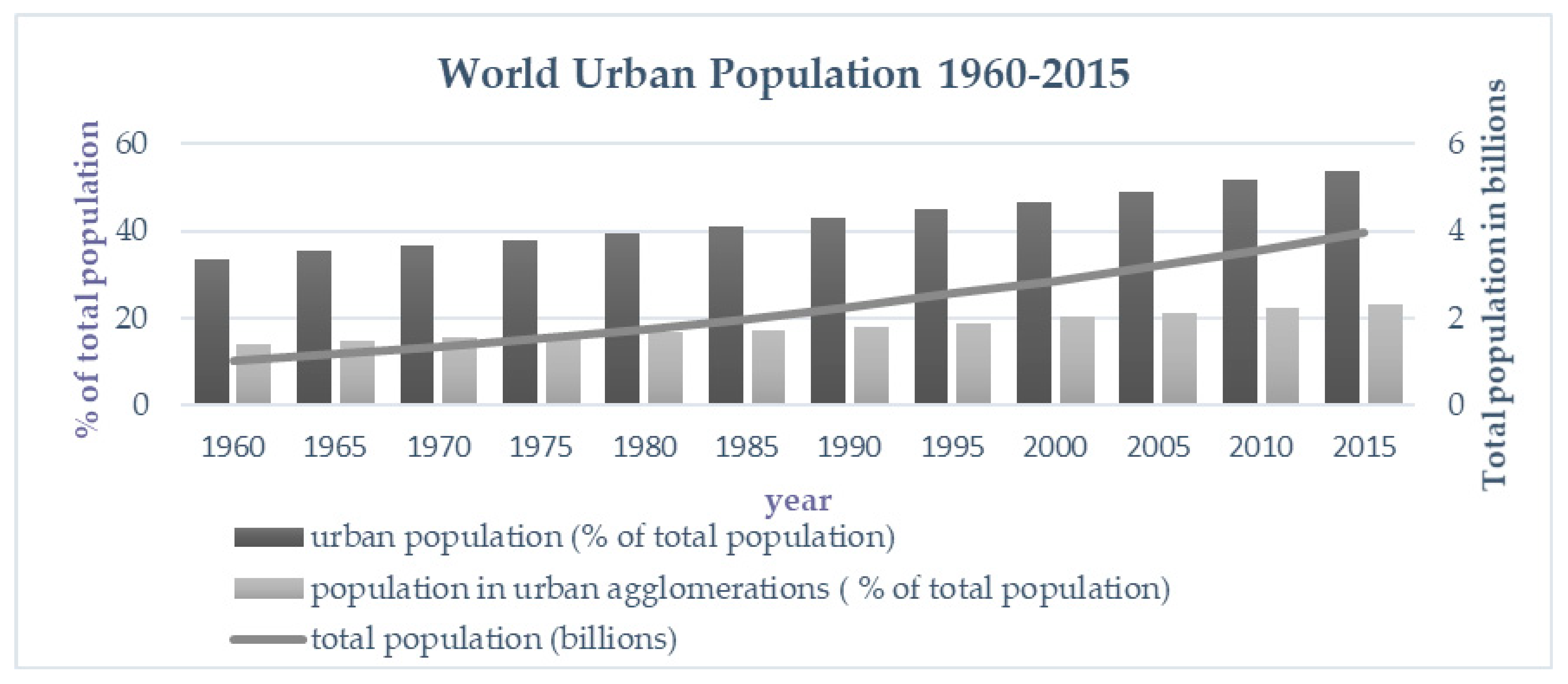
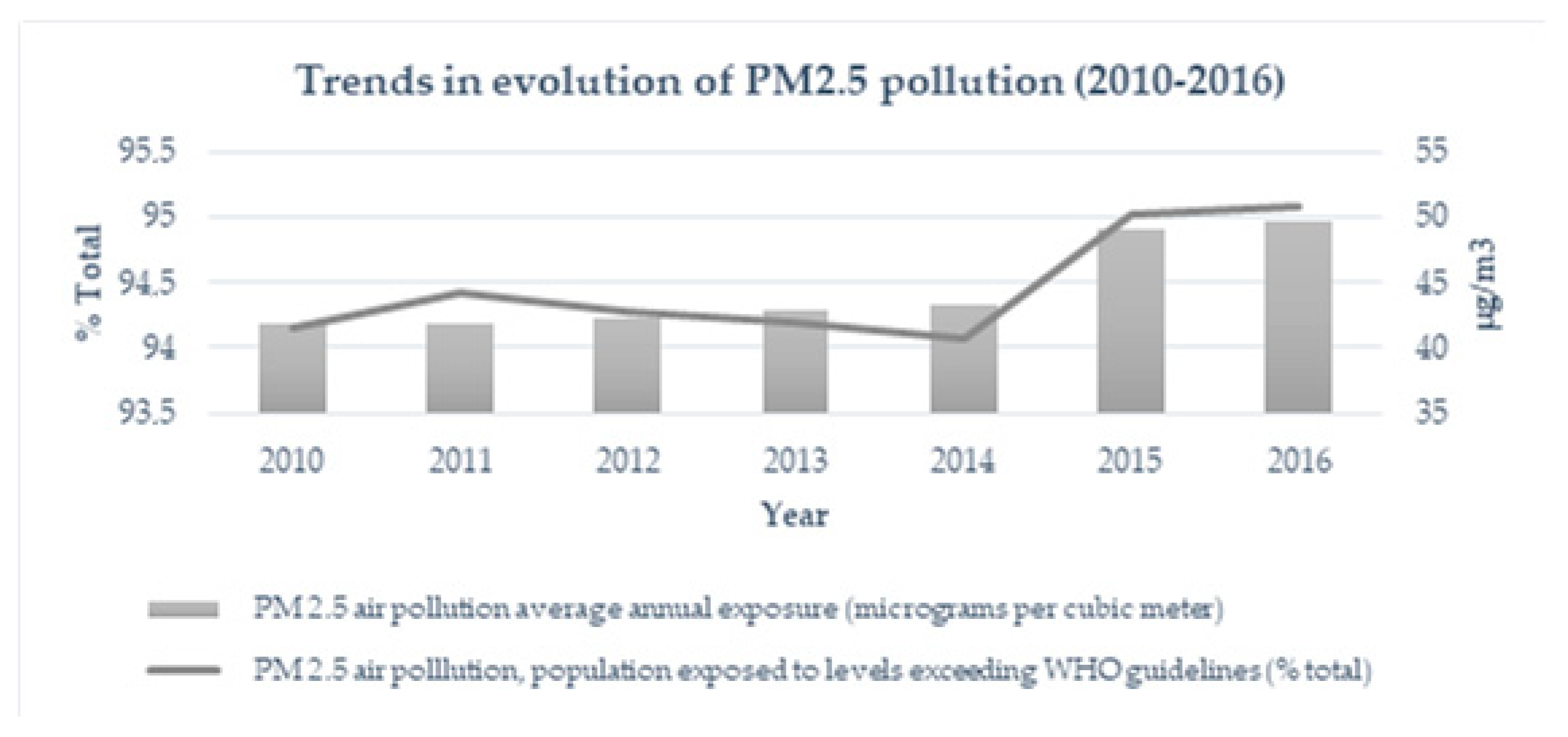
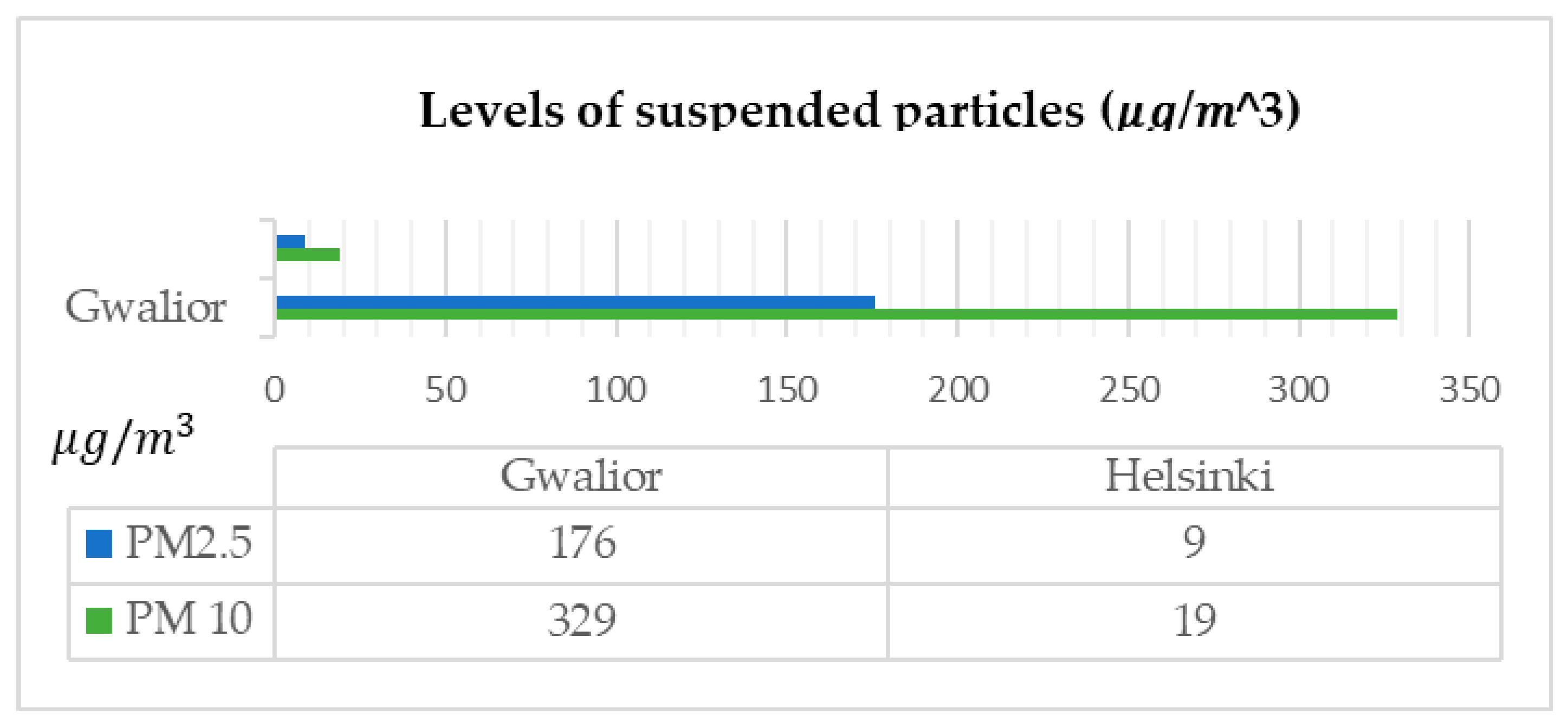


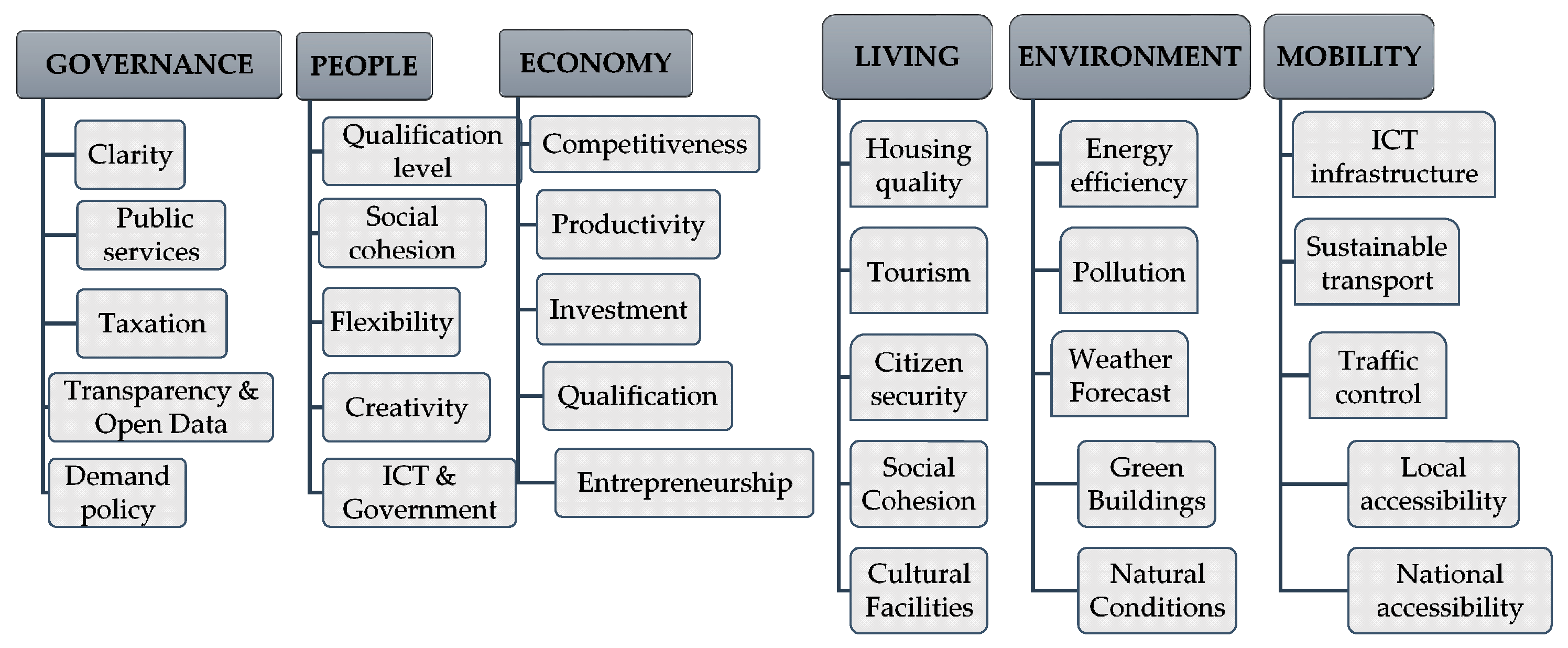
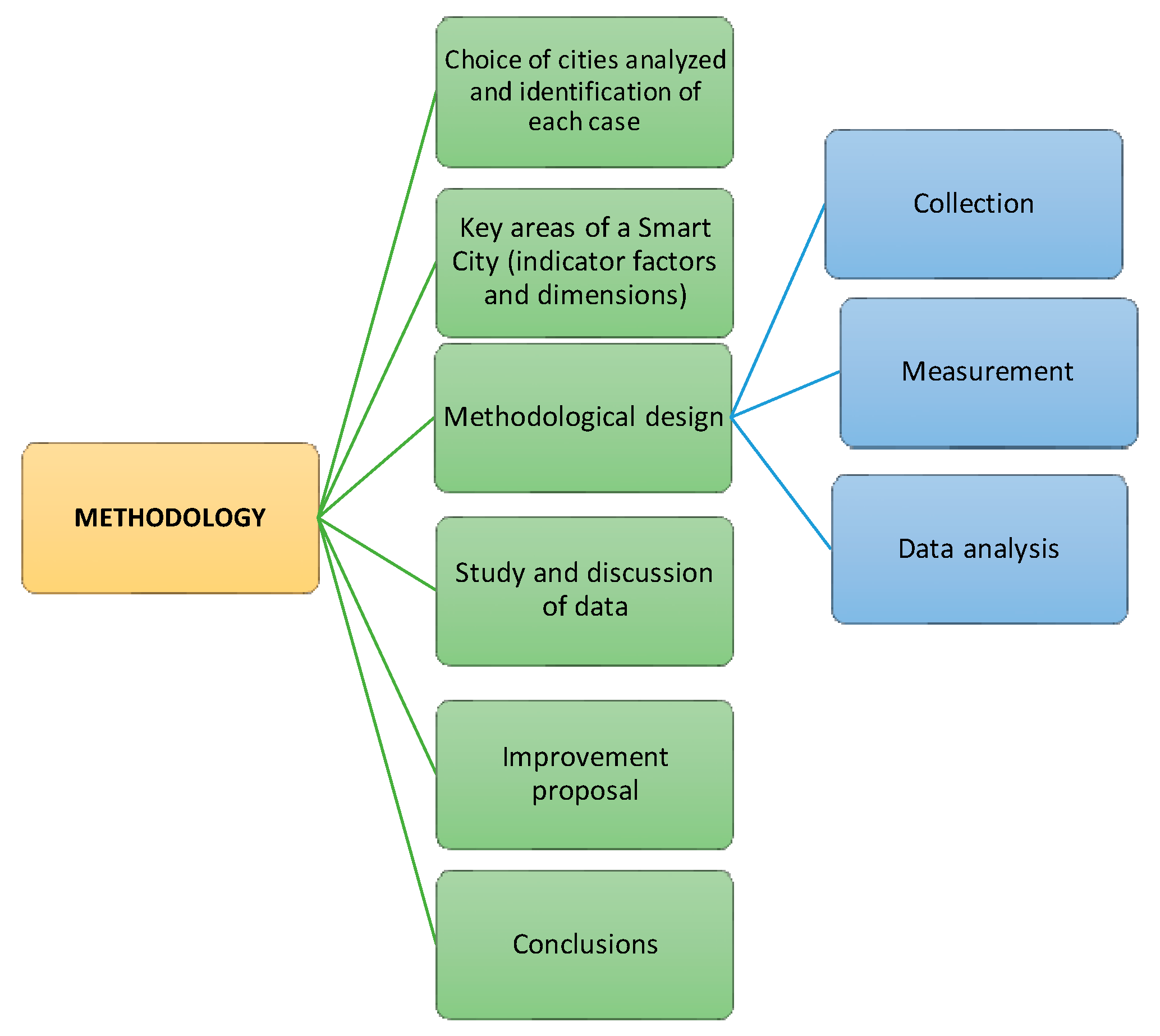

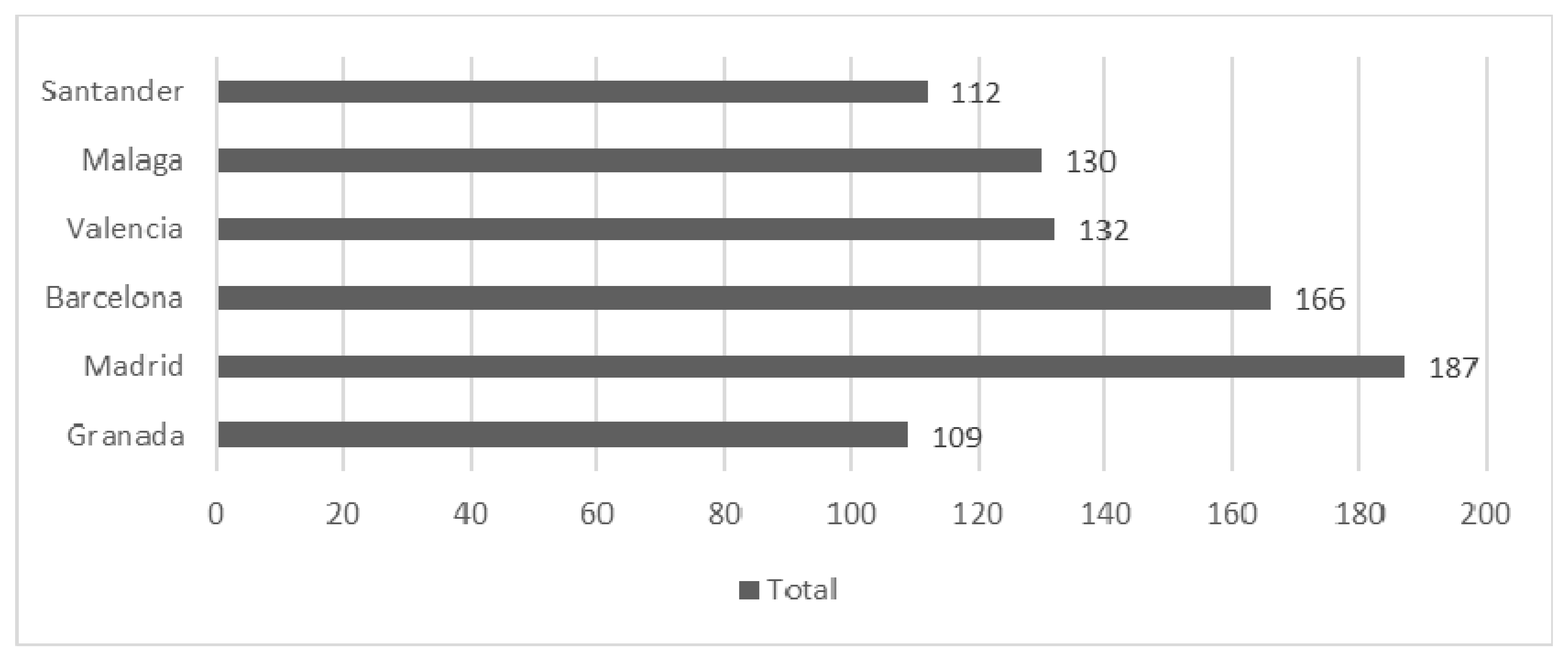
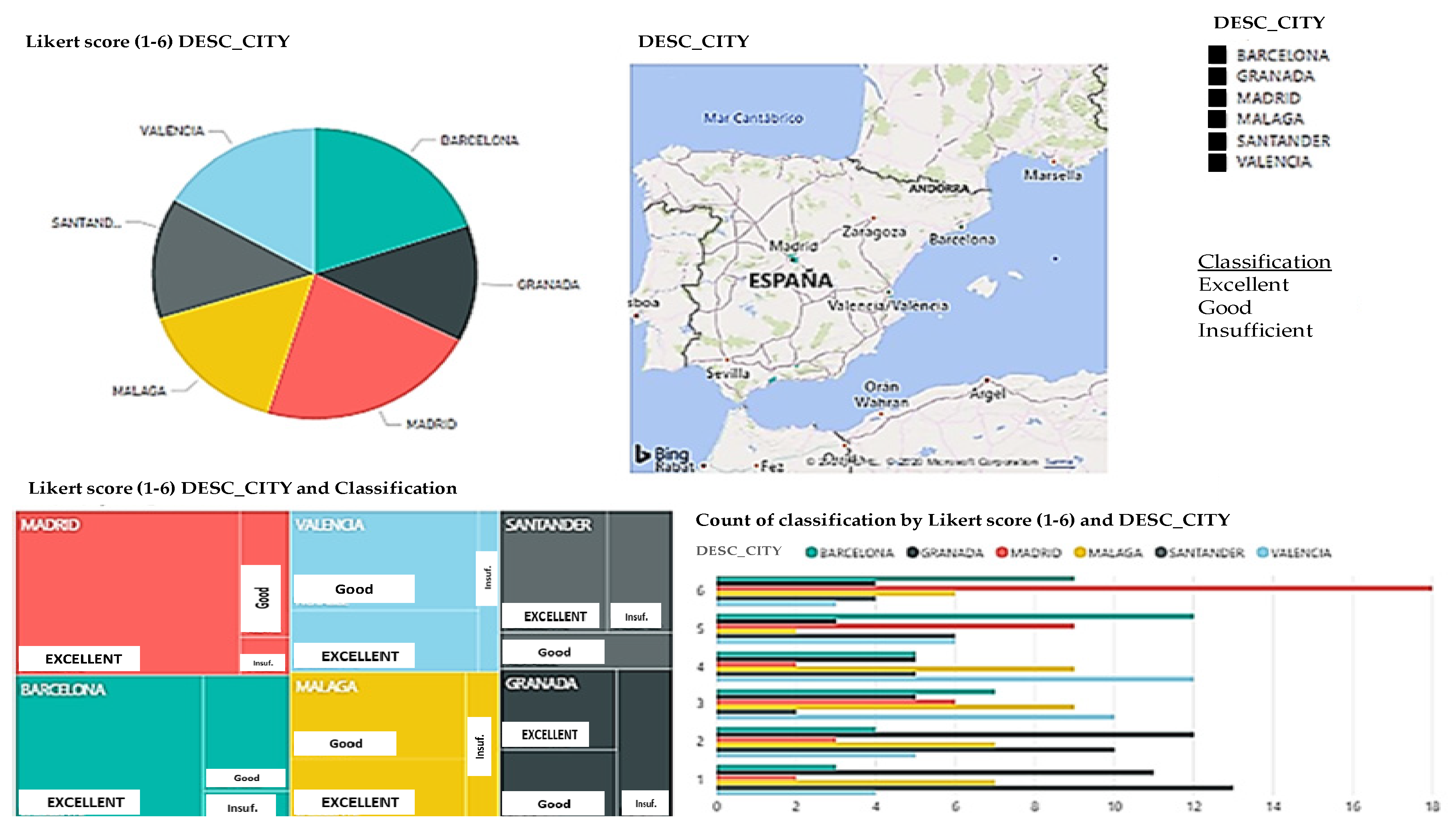
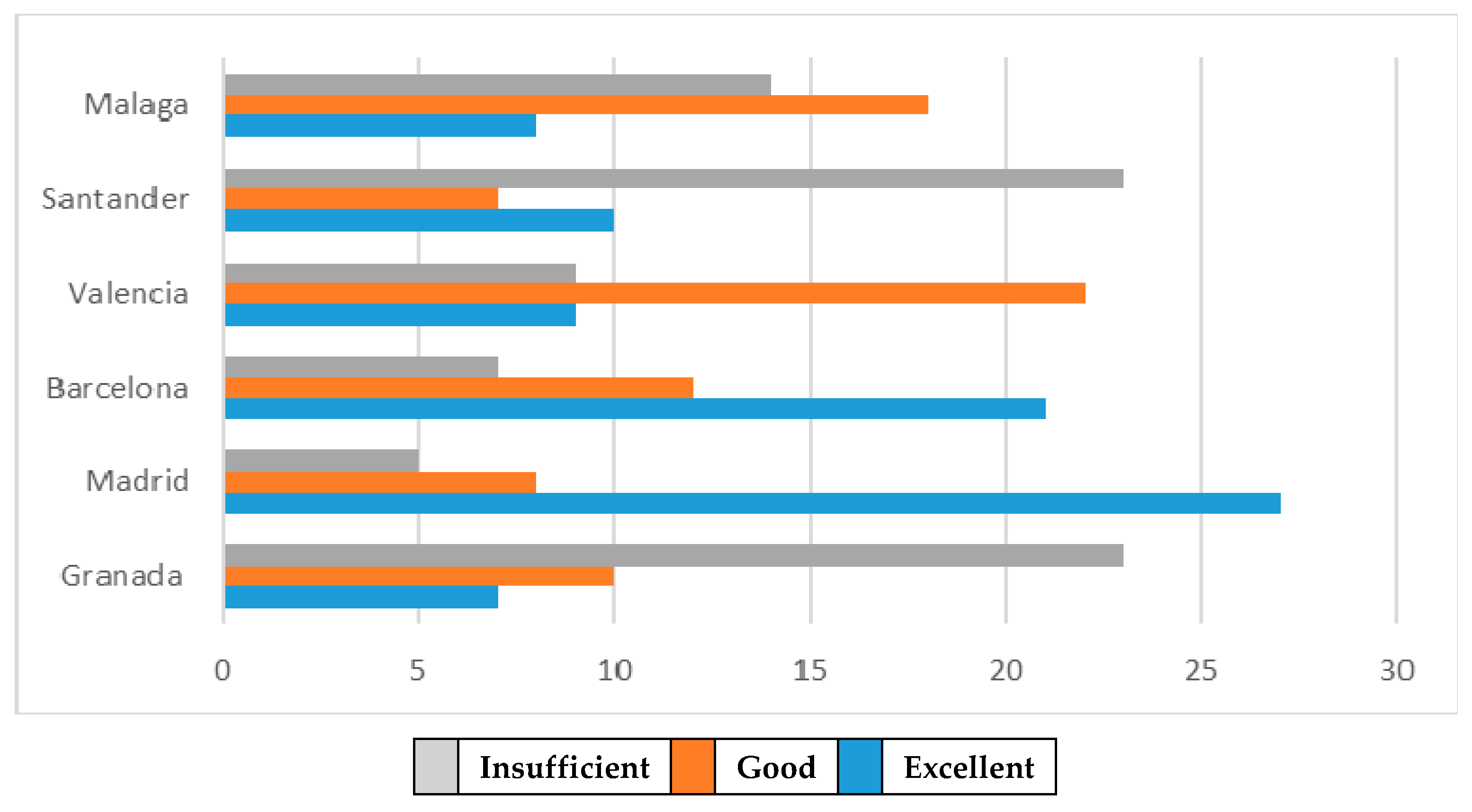
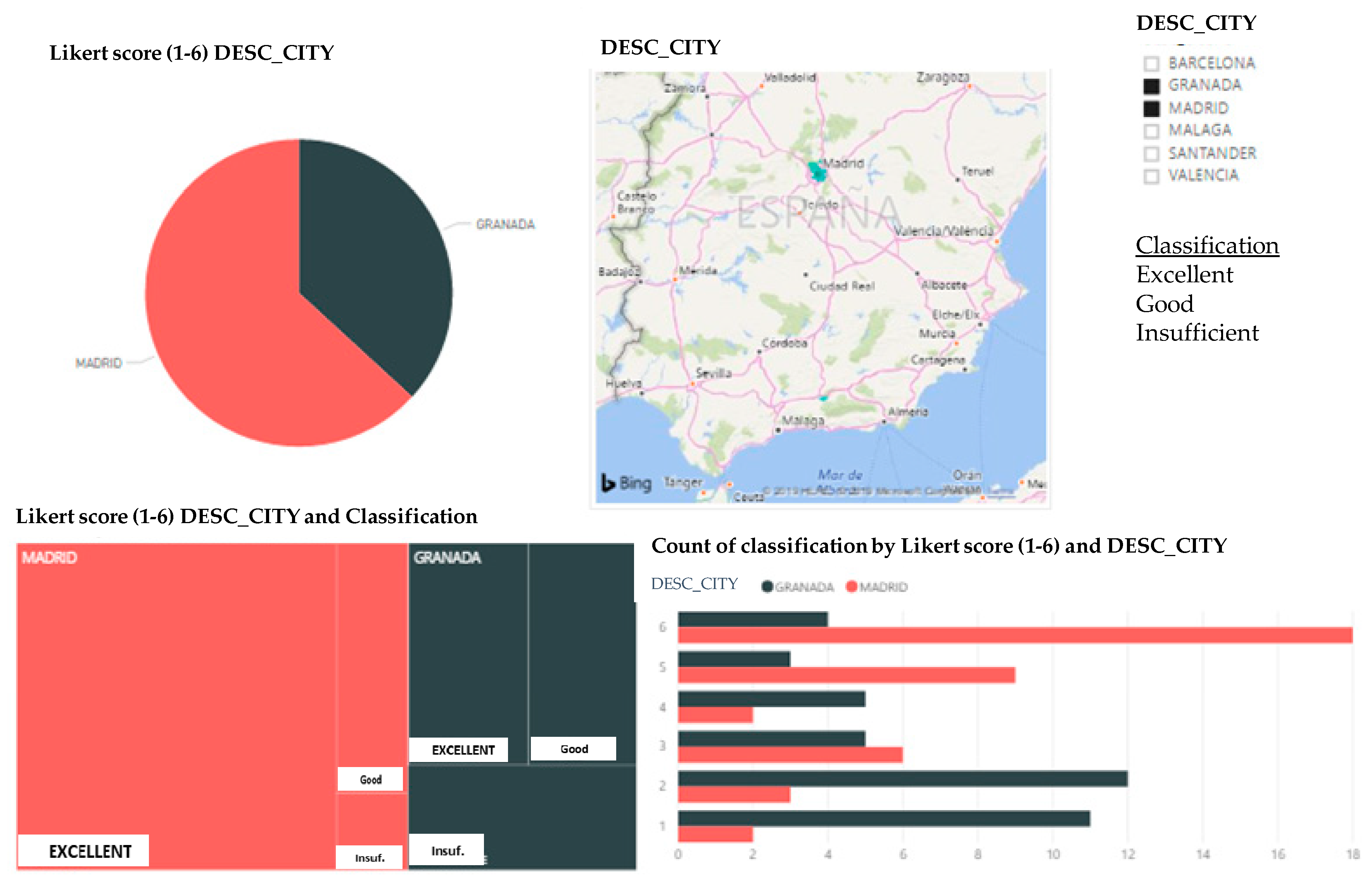
| Main Sources of Pollution | Values Established in Directives | |
|---|---|---|
| Average Value Accepted | Real Value Produced | |
| Particulate matter (PM) | PM 2.5: 10 µg/m3 annual average PM 10: 20 µg/m3 annual average | PM 2.5: 25 µg/m3 average in 24 h PM 10: 50 µg/m3 average in 24 h |
| Nitrogen Dioxide (NO2) | 40 µg/m3 annual average | 200 µg/m3 average in 1 h |
| Sulphur Dioxide (SO2) | 20 µg/m3 average in 24 h | 500 µg/m3 average in 10 min |
| ID_INDICATOR | DESC_INDICATOR |
|---|---|
| 1 | No. of reusable open databases |
| 2 | Number of ambulances per 1000 inhabitants |
| 3 | Number of firefighters per 1000 inhabitants |
| 4 | Average response time to an emergency |
| 5 | Number of police officers per 1000 inhabitants |
| 6 | Communication by social networks |
| 7 | Citizen-government channels |
| 8 | Procedures carried out online per total procedures |
| 9 | Polls |
| 10 | Number of kilometers of bicycle paths |
| 11 | Number of electric vehicle charging stations |
| 12 | Number of traffic accidents per 1000 inhabitants |
| 13 | % of trips by public transport |
| 14 | Density of the public transport network (m/km2) |
| 15 | Number of active buses 100,000 |
| 16 | Number of metro stations per 100,000 |
| 17 | % of clean energy use over total energy use |
| 18 | Approximate consumption of electrical energy (kWh) |
| 19 | Approximate number of smart meters |
| 20 | Average daily NO2 concentration (µg/m3) |
| 21 | Number of trees in urban spaces |
| 22 | M2 of green spaces, excluding rural spaces |
| 23 | Per capita CO2 emissions |
| 24 | Total water consumption per inhabitant (liters/day) |
| 25 | Total volume of waste generated by the city in kg per person per year |
| 26 | Percentage of solid waste recycled |
| 27 | Unemployment rate |
| 28 | GDP per capita (thousands of euros) |
| 29 | Number of new patents per year per 100,000 inhabitants |
| 30 | Number of airports |
| 31 | Percentage of foreign population |
| 32 | Number of 4- and 5-star hotel rooms |
| 33 | Number of tourists visiting the city |
| 34 | Number of international events (conferences and fairs) per year |
| 35 | Public services for people with reduced mobility (ramps, elevators, escalators, etc.) |
| 36 | Auditory communication in public services (acoustic alarms) |
| 37 | % of employed people with disabilities |
| 38 | Number of hospitals |
| 39 | Life expectancy at birth (years) |
| 40 | Number of births per year |
| 41 | Percentage of population living in poverty |
| 42 | Number of homeless people per 1000 inhabitants |
| ID_GLOBAL | DESC_GLOBAL |
|---|---|
| 1 | Governance |
| 2 | Mobility |
| 3 | Environment |
| 4 | Economy |
| 5 | Quality of Life |
| ID_FACTORS | DESC_FACTORS |
|---|---|
| 1 | Open data |
| 2 | Emergency Citizen Attention |
| 3 | e-Government |
| 4 | Institutionality |
| 5 | Efficiency |
| 6 | Security |
| 7 | Public Transport |
| 8 | Energy |
| 9 | Air Quality |
| 10 | Urban Spaces |
| 11 | Carbon Dioxide Levels |
| 12 | Water Consumption |
| 13 | Spillage and Waste |
| 14 | Employment |
| 15 | Productivity |
| 16 | Internationalization |
| 17 | Universal Accessibility |
| 18 | Healthcare |
| 19 | Social Cohesion |
| Item | Factor | Indicator |
|---|---|---|
| Governance | Open Data | No. of reusable open databases |
| Emergency Citizen Attention | Number of ambulances per 1000 inhabitants | |
| Number of firefighters per 1000 inhabitants | ||
| Average response time to an emergency | ||
| Number of police officers per 1000 inhabitants | ||
| E-Government | Communication by social networks | |
| Citizen-government channels | ||
| Procedures carried out online/total procedures | ||
| Institutionality | Polls | |
| Mobility | Efficiency | Number of kilometers of bicycle paths |
| Number of electric vehicle charging stations | ||
| Security | Number of traffic accidents per 1000 inhabitants | |
| Public Transport | % of trips by public transport | |
| Density of public transport network (m/km2) | ||
| Number of active buses 100,000 | ||
| Number of metro stations per 100,000 | ||
| Environment | Energy | % of clean energy use/total energy use |
| Approximate consumption of electrical energy (kWh) | ||
| Approximate number of smart meters | ||
| Air Quality | Average daily NO2 concentration (µg/m3) | |
| Urban spaces | Number of trees in urban spaces | |
| M2 of green spaces, excluding rural spaces. | ||
| Carbon Dioxide Levels | Per capita CO2 emissions. | |
| Water Consumption | Total water consumption per inhabitant (liters/day) | |
| Spillage and Waste | Total volume of waste generated by the city in kg per person per year | |
| Percentage of solid waste recycled | ||
| Economy | Employment | Unemployment rate |
| Productivity | GDP per capita (thousands of euros) | |
| Number of new patents per year per 100,000 inhabitants | ||
| Internationalization | Number of airports | |
| Percentage of foreign population | ||
| Number of 4- and 5-star hotel rooms | ||
| Number of tourists visiting the city | ||
| Number of international events (conferences and fairs) per year | ||
| Quality of life | Universal Accessibility | Public services for people with reduced mobility (ramps, elevators, escalators etc.). |
| Auditory communication in public services (acoustic alarms) | ||
| % of people with disabilities with work | ||
| Healthcare | Number of hospitals | |
| Life expectancy at birth (years) | ||
| Number of births per year | ||
| Social Cohesion | Percentage of population living in poverty | |
| Number of homeless people per 1000 inhabitants |
| Item | Factor | Smart Cities | |||||
|---|---|---|---|---|---|---|---|
| Granada | Madrid | Barcelona | Malaga | Valencia | Santander | ||
| Governance | Open Data | X | X | ||||
| Emergency Citizen Attention | X | X | X | X | X | X | |
| E-Government | X | X | |||||
| Institutionality | |||||||
| Mobility | Efficiency | X | X | X | |||
| Security | X | ||||||
| Public Transport | X | X | X | X | X | ||
| Environment | Energy | X | X | ||||
| Air Quality | |||||||
| Urban spaces | X | X | X | ||||
| Carbon Dioxide Levels | X | X | X | ||||
| Water Consumption | X | X | |||||
| Spillage and Waste | X | X | |||||
| Economy | Employment | X | X | X | |||
| Productivity | X | X | |||||
| Internationalization | X | X | X | X | |||
| Quality of life | Universal Accessibility | X | |||||
| Healthcare | X | X | X | ||||
| Social Cohesion | X | X | X | ||||
| DESC_GLOBAL | DESC_FACTORS | DESC_INDICATOR | |
|---|---|---|---|
| Governance | Emergency citizen attention | Number of ambulances per 1000 inhabitants | RQ1 |
| Governance | Emergency citizen attention | Number of firefighters per 1000 inhabitants | RQ1 |
| Governance | E-government | Procedures carried out online/total procedures | RQ1 |
| Governance | Open data | No. of reusable open databases | RQ1 |
| Governance | E-government | Citizen-government channels | RQ1 |
| Mobility | Efficiency | Number of electric vehicle charging stations | RQ2 |
| Mobility | Efficiency | Number of kilometers of bicycle paths | RQ2 |
| Mobility | Public Transport | Number of active buses (100,000 hab) | RQ2 |
| Mobility | Public Transport | Density of the public transport network (m/km2) | RQ2 |
| Mobility | Public Transport | Number of metro stations per 100,000 | RQ2 |
| Environment | Air quality | Number of trees in urban spaces | RQ3 |
| Environment | Air quality | M2 of green spaces, excluding rural spaces. | RQ3 |
| Environment | Waste | Percentage of solid waste recycled | RQ3 |
| Economy | Internationalization | Percentage of foreign population | RQ4 |
| Economy | Internationalization | Number of 4-and 5-star hotel rooms | RQ4 |
| Economy | Employment | Unemployment rate | RQ4 |
| Quality of life | Universal accessibility | % of employed people with disabilities | RQ5 |
| Quality of life | Universal accessibility | Auditory communication in public services (acoustic alarms) | RQ5 |
| Quality of life | Social Cohesion | Percentage of population living in poverty | RQ5 |
| Quality of life | Social Cohesion | Number of homeless people per 1000 inhabitants | RQ5 |
| Quality of life | Healthcare | Life expectancy at birth (years) | RQ5 |
| Quality of life | Healthcare | Number of hospitals | RQ5 |
| Quality of life | Healthcare | Number of doctor (1000 hab) | RQ5 |
© 2020 by the authors. Licensee MDPI, Basel, Switzerland. This article is an open access article distributed under the terms and conditions of the Creative Commons Attribution (CC BY) license (http://creativecommons.org/licenses/by/4.0/).
Share and Cite
Ortega-Fernández, A.; Martín-Rojas, R.; García-Morales, V.J. Artificial Intelligence in the Urban Environment: Smart Cities as Models for Developing Innovation and Sustainability. Sustainability 2020, 12, 7860. https://doi.org/10.3390/su12197860
Ortega-Fernández A, Martín-Rojas R, García-Morales VJ. Artificial Intelligence in the Urban Environment: Smart Cities as Models for Developing Innovation and Sustainability. Sustainability. 2020; 12(19):7860. https://doi.org/10.3390/su12197860
Chicago/Turabian StyleOrtega-Fernández, Anabel, Rodrigo Martín-Rojas, and Víctor Jesús García-Morales. 2020. "Artificial Intelligence in the Urban Environment: Smart Cities as Models for Developing Innovation and Sustainability" Sustainability 12, no. 19: 7860. https://doi.org/10.3390/su12197860
APA StyleOrtega-Fernández, A., Martín-Rojas, R., & García-Morales, V. J. (2020). Artificial Intelligence in the Urban Environment: Smart Cities as Models for Developing Innovation and Sustainability. Sustainability, 12(19), 7860. https://doi.org/10.3390/su12197860






